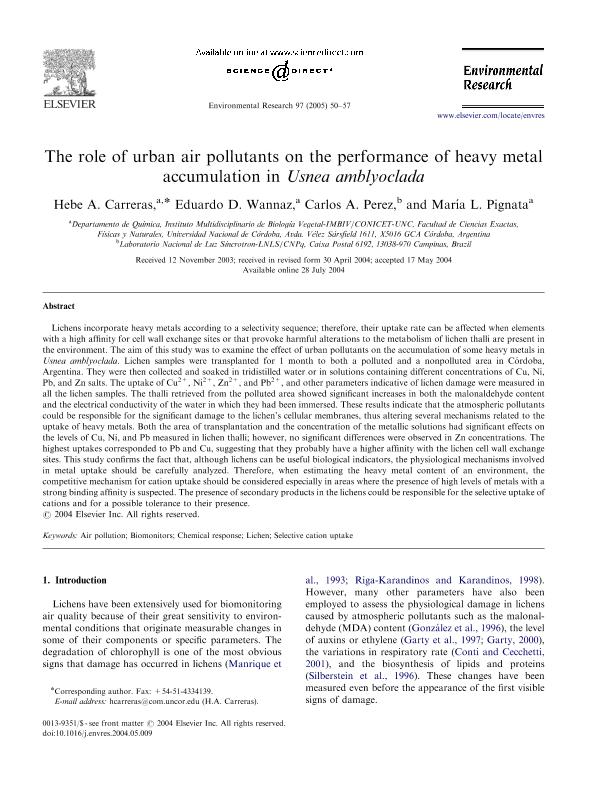Mostrar el registro sencillo del ítem
dc.contributor.author
Carreras, Hebe Alejandra

dc.contributor.author
Wannaz, Eduardo Daniel

dc.contributor.author
Pérez, Carlos A.
dc.contributor.author
Pignata, Maria Luisa

dc.date.available
2017-12-20T13:04:24Z
dc.date.issued
2005-01
dc.identifier.citation
Pignata, Maria Luisa; Pérez, Carlos A.; Wannaz, Eduardo Daniel; Carreras, Hebe Alejandra; The role of urban air pollutants on the heavy metals accumulation performance of Usnea amblyoclada; Academic Press Inc Elsevier Science; Environmental Research; 97; 1; 1-2005; 50-57
dc.identifier.issn
0013-9351
dc.identifier.uri
http://hdl.handle.net/11336/31086
dc.description.abstract
Lichens incorporate heavy metals according to a selectivity sequence; therefore, their uptake rate can be affected when elements with a high affinity for cell wall exchange sites or that provoke harmful alterations to the metabolism of lichen thalli are present in the environment.The aim of this study was to examine the effect of urban pollutants on the accumulation of some heavy metals in Usnea amblyoclada.Lichen samples were transplanted for 1 month to both a polluted and a nonpolluted area in Córdoba, Argentina.They were then collected and soaked in tridistilled water or in solutions containing different concentrations of Cu, Ni,
Pb, and Zn salts.The uptake of Cu2+, Ni2+, Zn2+, and Pb2+, and other parameters indicative of lichen damage were measured in all the lichen samples.The thalli retrieved from the polluted area showed significant increases in both the malonaldehyde content and the electrical conductivity of the water in which they had been immersed.These results indicate that the atmospheric pollutants could be responsible for the significant damage to the lichen’s cellular membranes, thus altering several mechanisms related to the uptake of heavy metals.Both the area of transplantation and the concentration of the metallic solutions had significant effects on the levels of Cu, Ni, and Pb measured in lichen thalli; however, no significant differences were observed in Zn concentrations.The highest uptakes corresponded to Pb and Cu, suggesting that they probably have a higher affinity with the lichen cell wall exchange sites.This study confirms the fact that, although lichens can be useful biological indicators, the physiological mechanisms involved in metal uptake should be carefully analyzed.Therefore, when estimating the heavy metal content of an environment, the competitive mechanism for cation uptake should be considered especially in areas where the presence of high levels of metals with a strong binding affinity is suspected.The presence of secondary products in the lichens could be responsible for the selective uptake of cations and for a possible tolerance to their presence.
dc.format
application/pdf
dc.language.iso
eng
dc.publisher
Academic Press Inc Elsevier Science

dc.rights
info:eu-repo/semantics/openAccess
dc.rights.uri
https://creativecommons.org/licenses/by-nc-sa/2.5/ar/
dc.subject.classification
Meteorología y Ciencias Atmosféricas

dc.subject.classification
Ciencias de la Tierra y relacionadas con el Medio Ambiente

dc.subject.classification
CIENCIAS NATURALES Y EXACTAS

dc.title
The role of urban air pollutants on the heavy metals accumulation performance of Usnea amblyoclada
dc.type
info:eu-repo/semantics/article
dc.type
info:ar-repo/semantics/artículo
dc.type
info:eu-repo/semantics/publishedVersion
dc.date.updated
2017-11-16T15:17:50Z
dc.journal.volume
97
dc.journal.number
1
dc.journal.pagination
50-57
dc.journal.pais
Países Bajos

dc.journal.ciudad
Amsterdam
dc.description.fil
Fil: Carreras, Hebe Alejandra. Consejo Nacional de Investigaciones Científicas y Técnicas. Centro Científico Tecnológico Conicet - Córdoba. Instituto Multidisciplinario de Biología Vegetal. Universidad Nacional de Córdoba. Facultad de Ciencias Exactas Físicas y Naturales. Instituto Multidisciplinario de Biología Vegetal; Argentina
dc.description.fil
Fil: Wannaz, Eduardo Daniel. Consejo Nacional de Investigaciones Científicas y Técnicas. Centro Científico Tecnológico Conicet - Córdoba. Instituto Multidisciplinario de Biología Vegetal. Universidad Nacional de Córdoba. Facultad de Ciencias Exactas Físicas y Naturales. Instituto Multidisciplinario de Biología Vegetal; Argentina
dc.description.fil
Fil: Pérez, Carlos A.. Laboratorio Nacional de Luz Síncrotron-LNLS/CNPq; Brasil
dc.description.fil
Fil: Pignata, Maria Luisa. Consejo Nacional de Investigaciones Científicas y Técnicas. Centro Científico Tecnológico Conicet - Córdoba. Instituto Multidisciplinario de Biología Vegetal. Universidad Nacional de Córdoba. Facultad de Ciencias Exactas Físicas y Naturales. Instituto Multidisciplinario de Biología Vegetal; Argentina
dc.journal.title
Environmental Research

dc.relation.alternativeid
info:eu-repo/semantics/altIdentifier/url/https://www.sciencedirect.com/science/article/pii/S0013935104000957
dc.relation.alternativeid
info:eu-repo/semantics/altIdentifier/doi/https://doi.org/10.1016/j.envres.2004.05.009
Archivos asociados
